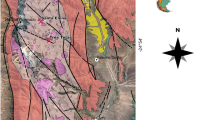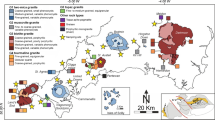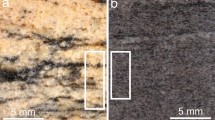Summary
Granitic pegmatites characterized by advanced accumulation and fractionation of incompatible rare lithophile elements (Li, Rb, Cs, Be, Ta ≶ Nb, B, P and F), often contain mineral assemblages which host lithium-rich micas. Lepidolite and lithian muscovite occur in high-pressure spodumene, low-pressure petalite, phosphorus-enriched amblygonite and fluorine-rich lepidolite subtypes of orogenic affiliated complex type granitic pegmatites and rarely in anorogenic affiliated amazonite-bearing
Trace element data determined by X-ray fluorescence for lepidolite of various pegmatite subtypes, morphology (“book”, “scaly”, “fine-grained”), position within the pegmatite (primary zones, replacement units, pockets), mineral assemblages and tectonic affinity (orogenic vs anorogenic) show extreme fractionation of Rb and Cs; modest levels of T1, Ga, Nb, Ta, Sn and Zn; and typically low abundances of Ba, Sr, Ni, Pb, Y, V, W and Zr. Extreme fractionation is indicated by low values of K/Rb, K/Cs and Nb/Ta which are lowest in lepidolite from petalite subtype pegmatites.
No systematic differences in trace element content is evident among the different lepidolite morphologies or paragenetic position. Lepidolite from spodumene subtype pegmatites are generally slightly less fractionated than those from petalite or lepidolite subtype pegmatites.
Zusammenfassung
Granitische Pegmatite, die durch fortgeschrittene Anreicherung und Fraktionierung von inkompatiblen, seltenen, lithophilen Elementen (Li, Rb, Cs, Be, Ta Nb, B, P und F) charakterisiert sind, enthalten häufig Mineralparagenesen mit Lithium-reichen Glimmern. Lepidolith und Li-Muskowit treten in Hochdruck-Spodumen, in Niedrigdruck-Petalit, in mit Phosphor angereichertem Amblygonit und in Fluor-reichen Lepidolith-Unterarten aus komplexen orogenen granitischen Pegmatiten und selten auch aus anorogenen, Amazonit-führenden Pegmatiten, auf.
Spurenelement-Daten aus der Röntgenfluoreszenzanalyse von Lepidolith aus verschiedenen Pegmatit-Untertypen, die Morphologie (tafelig, schuppig, feinkörnig), die Position innerhalb des Pegmatits (primäre Zonen, verdrängte Einheiten, Taschen), Mineralbestände und tektonische Affinität (orogen gegen anorogen) zeigen eine extreme Fraktionierung von Rb und Cs, bescheidene Gehalte an TI, Ga, Nb, Ta, Sn und Zn; und typischerweise geringe Häufigkeiten von Ba, Sr, Ni, Pb, Y, V, W und Zr. Die extreme Fraktionierung wird durch niedrige Werte von K/Rb, K/Cs und Nb/Ta angezeigt, die in Lepidolith von Pegmatiten des Petalit-Subtyps am niedrigsten sind.
Aus den verschiedenen Morphologien oder paragenetischen Positionen von Lepidolith sind keine systematischen Unterschiede im Spurenelementgehalt ersichtlich. Lepidolith aus Pegmatiten des Spodumen-Subtyps sind generell etwas weniger fraktioniert als jene von Pegmatiten des Petalit- oder Lepidolith-Subtyps.
Similar content being viewed by others
References
Borovik-Romanova TF, Sosedko AF (1960) Thallium-rubidium ratio in minerals from the Kola Peninsula pegmatites according to the data of spectrographic analysis. Geochemistry: 34–42
Burt DM, London D (1982) Subsolidus equilibria. In:Černý P (ed) Granitic pegmatites in science and industry. Mineral Assoc Can Short Course Handb 8: 329–346
Černý P (1989) Characteristics of pegmatite deposits of tantalum. In:Möller P, Cerný P, Saupé F (eds) Lanthanides, tantalum and niobium: Society for Geology Applied to Mineral Deposits. Special Publication 7. Springer, Berlin Heidelberg New York Tokyo, pp 192–236
Černý P. Burt DM (1984) Paragenesis, crystallochemical characteristics, and geochemical evolution of micas in granite pegmatites. In:Bailey SW (ed) Micas. Mineral Soc Am Rev Mineral 13: 257–297
Černý P, Meintzer, RE, Anderson, AJ (1985) Extreme fractionation in rare-element granitic pegmatites: selected examples of data and mechanisms. Can Mineral 23: 381–421
Černý P, Staněk J, Novák M, Baadsgaard H, Rieder M, Ottolini L, Kavalová M, Chapman R (1995) Geochemical and structural evolution of micas in the Rožná and Dobrá Voda pegmatites, Czech Republic. Mineral Petrol 55 (this volume)
Černý P, Trueman DL, Ziehlke DV, Goad BE, Paul BJ (1981) The Cat Lake-Winnipeg River and the Wekusko Lake pegmatite fields, Manitoba. Man Mineral Res Div Econ Geol Rept. ER80-1, 240 p
Chaudhry MN, Howie RA (1973) Lithium-aluminum micas from the Meldon aplite, Devonshire, England. Mineral Mag 39: 289–296
Foord EE (1976) Mineralogy and petrogenesis of layered Pegmatite-Aplite Dikes in the Mesa Grande District, San Diego County, California. Thesis, Stanford University. Palo Alto, California
Foord EE, Černý P, Jackson LL, Sherman DM, Eby RK (1995) Mineralogical and geochemical evolution of micas from miarolitic pegmatites of the anorogenic Pikes Peak Batholith, Colorado. Mineral Petrol 55 (this volume)
Foord EE, Spaulding LB, Mason RA, Martin RF (1989) Mineralogy and paragenesis of the Little Three mine pegmatites, Ramona district, San Diego County, California. Mineral Rec 20: 101–127
Heinrich EW (1967) Micas of the Brown Derby pegmatites, Gunnison County, Colorado. Am Mineral 52: 1110–1121
Jambor JL, Potter RR (1967) Rubidium-bearing dykes, Gods Lake area, Manitoba. Geol Surv Can Paper 67–15
Lahti S (1981) On the granitic pegmatites of the Eräjärvi area in Orivesi, southern Finland. Bull Geol Surv Finland 314, 82 p
Levinson AA (1953) Studies in the mica group; relationship between polymorphism and composition in the muscovite-lepidolite system. Am Mineral 38: 88–107
London D (1982) Stability of spodumene in acidic and saline fluorine-rich enrichments. Carnegie Inst Geophys Lab Rep 81: 331–334
London D (1984) Experimental phase equilibria in the system LiAlSiO4-SiO2-H2O: a petrogenetic grid for lithium-rich pegmatites. Am Mineral 69: 995–1004
Lopes Nunes JE (1971) Contribution á l'étude minéralogique et géochimique des pegmatites du Mozambique. Sci de la Terre, Nancy, Mém 26, 261 p
Quensel P (1956) The paragenesis of the Varuträsk pegmatite, including a review of its mineral assemblages. Ark Mineral Geol 2: 9 126
Rinaldi R, Černý P, Ferguson RB (1972) The Tanco pegmatite at Bernic Lake, Manitoba. VI. Lithium-rubidium-cesium micas. Can Mineral 11: 635–637
Slepnev YuS (1964) Geochemical characteristics of the rare-metal granitic pegmatites of the Sayan Mountains. Geochemistry: 221–228
Author information
Authors and Affiliations
Additional information
With 4 Figures
Rights and permissions
About this article
Cite this article
Wise, M.A. Trace element chemistry of lithium-rich micas from rare-element granitic pegmatites. Mineralogy and Petrology 55, 203–215 (1995). https://doi.org/10.1007/BF01162588
Received:
Accepted:
Issue Date:
DOI: https://doi.org/10.1007/BF01162588




